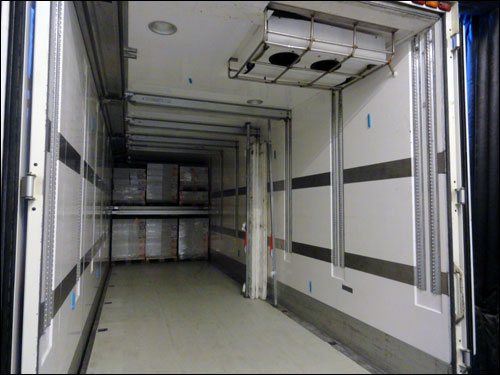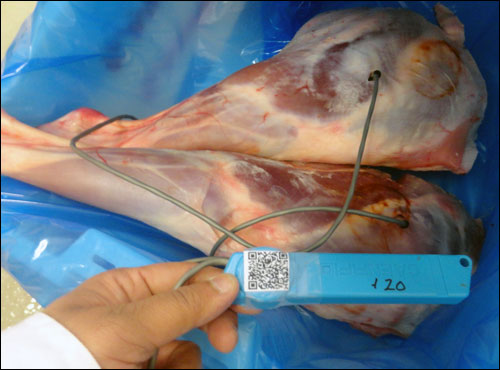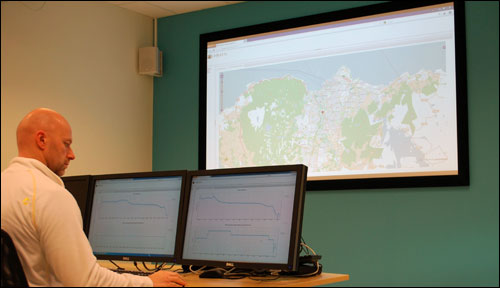The super-chilling of food products below the freezing point to stop bacteria growth is fairly commonplace with fish, according to Geir Vevle, the CTO of technology provider Hrafn, based in Norway. Although the same process could also stop bacteria growth in meat products (thereby extending the meat’s shelf life by weeks), few meat producers or companies in the supply chain super-chill meat, he says, because the temperature threshold is very tight. Temperatures must remain colder than 0 degrees Celsius (+32 degrees Fahrenheit), but not fall below -1.7 degrees Celsius (+28.9 degrees Fahrenheit), Vevle explains, or the quality of the fresh meat could degrade. Ensuring that temperatures stay within those perimeters can be difficult, he adds. Therefore, Hrafn, along with slaughterhouse Fatland Ølen and research organization Sintef, recently tested the use of RFID technology to track the temperatures of super-chilled meat products being transported from an abattoir to a distribution center in Norway.
The pilot was funded by a Norwegian government research council, as part of Norway’s KMB Lønnsom foredling (profitable processing) project, to improve and secure marine and agricultural food processing within that country. The KMB project includes plans to use technology to improve hygiene, cold chains and fresh-food traceability.

The temperature-tracking system, with RFID technology developed for Sintef by Hrafn, included RFID temperature sensor tags, passive ultrahigh-frequency (UHF) EPC Gen 2 RFID tags and 2-D bar-coded labels, as well as software based on EPCglobal‘s EPC Information Services (EPCIS) standard. The test was intended to ascertain the benefit of RFID UHF technology used in conjunction with temperature sensors, data loggers and a cellular connection, to monitor and transmit temperature data during the transport of chilled meat. While the study found, in fact, that the information could be collected by an EPCIS system, most of the RFID sensor tags were not read by the interrogator within the truck, because their signals were unable to pass through the densely packed meat. However, after the meat was removed from the truck, the researchers were able to collect the shipment’s temperature history by downloading information recorded by the data logger.
After Fatland slaughters and processes lamb at its Ølen facility, the company super-chills the meat prior to shipping it to its Trondheim distribution center. For the pilot, Hrafn equipped one truck with an RFID reader cabled to a computer equipped with a GPS unit and a GSM radio that could transmit data via a cellular connection to Hrafn’s EPCIS-based software. The goal, the company reports, was to test the sensor tags’ ability to verify that the meat was stored at the desired temperature (between 0 and -1.7 degrees Celsius) within the refrigerated truck for the duration of the 14-hour journey to the Trondheim DC.

Hrafn and Sintef spent two months studying the meat-chilling and transportation processes, testing the placement of tags in meat and within the truck, and establishing the EPCIS data-management application. The group selected RFID hardware from CAEN RFID, including two models of semi-passive UHF EPC Gen 2 sensor tags—the A927Z, a temperature logger with 16 kilobytes of memory (sufficient to record 8,000 temperature readings), and the A927ZET, which has an external probe so that it could be used to measure the internal temperature of a leg of lamb. For the test, carried out on Nov. 23, the truck was chilled using two cold-air blowers. Hrafn deployed nine A927Z RFID temperature sensor tags around the vehicle’s interior (one on the ceiling and four on each sidewall), in order to detect whether temperatures differed in various areas located either near or farther away from those blowers. Hrafn also inserted the probes of four A927ZET tags into four legs of lamb, in order to test any temperature fluctuations within the meat itself.
In addition, the system included the use of 2-D bar-coded labels taped to the sensor tags, which could be read using a mobile phone when the truck was loaded with pallets of lamb at the slaughterhouse, and again when the meat was received at the DC. In this way, the EPCIS system would retain a timestamp indicating when the product left the facility and when it was received. The researchers could have utilized the RFID tags to record these events, Vevle says, but they instead opted to use bar codes, which would enable staff members to read an ID number via a mobile phone rather than requiring handheld interrogators.
The truck’s reading unit, known as the Hrafn Online Container, consisted of a CAEN A941 reader and an Owasys GPS- and GSM-enabled industrial computer powered by an automotive battery. The reader was intended to capture each tag’s unique RFID number, as well as temperature sensor data, every 10 minutes. To accomplish this goal, the unit was placed within the truck, on the floor, in the space in which a pallet would have been loaded. The solution was designed so that whenever the reader captured data from the tags, the Owasys computer then forwarded that information, along with the truck’s GPS coordinates, to the EPCIS system on a standalone back-end system, via a GSM cellular radio, transmitting through the truck’s fiberglass walls.

Once the product was delivered to the Trondheim DC the following morning, the tags were removed from the product and truck, and were brought to Sintef’s Fisheries and Aquaculture lab. According to the company, the test results are still being analyzed.
During the transport, the reader received data from only three of the 13 temperature sensor tags. Vevle says that the group expected to find that only some of the sensors would be readable, given the difficulty for UHF RF signals to pass through items that contain lots of water, such as meat, especially when densely pack together. Anticipating this transmission challenge, researchers had chosen the tags that also acted as data loggers, thereby recording every temperature reading taken throughout the trip. Once the equipment and the sensors were removed from the vehicle at the Trondheim DC, the RFID equipment was set up again at the Sintef lab, to retrieve all of the temperature data, including data that was not transmitted to the reader while the meat was in transit.
Researchers were unable to collect the Hrafn Online Container’s GPS position of the transport vehicle, during this particular test, because of a human error in placement the antenna. “The concept, though, showed how location, temperature and time, in a very scalable way, can be collected and monitored for cold-chain applications,” Vevle says.
The analysis of the results is expected to be finished by Dec. 31, Vevle says, by which time the group expects to have determined whether the proper temperatures were maintained within the truck, and whether the online monitoring was found to be beneficial. According to Vevle, the research group found that using the RFID tags for tracking the temperature condition in the truck in real time “was overkill.” In the future, he says, the group will more likely only read the RFID tags’ stored sensor data after they are removed from the truck. “The conclusions made were overall very positive regarding the use of temperature tags for securing quality and documenting extended lifetime for products.”
In January 2012, Vevle says, Hrafn plans to participate in a second study, intended to track the temperatures of bakery items as they are shipped in chilled containers from a bakery to distribution centers.

